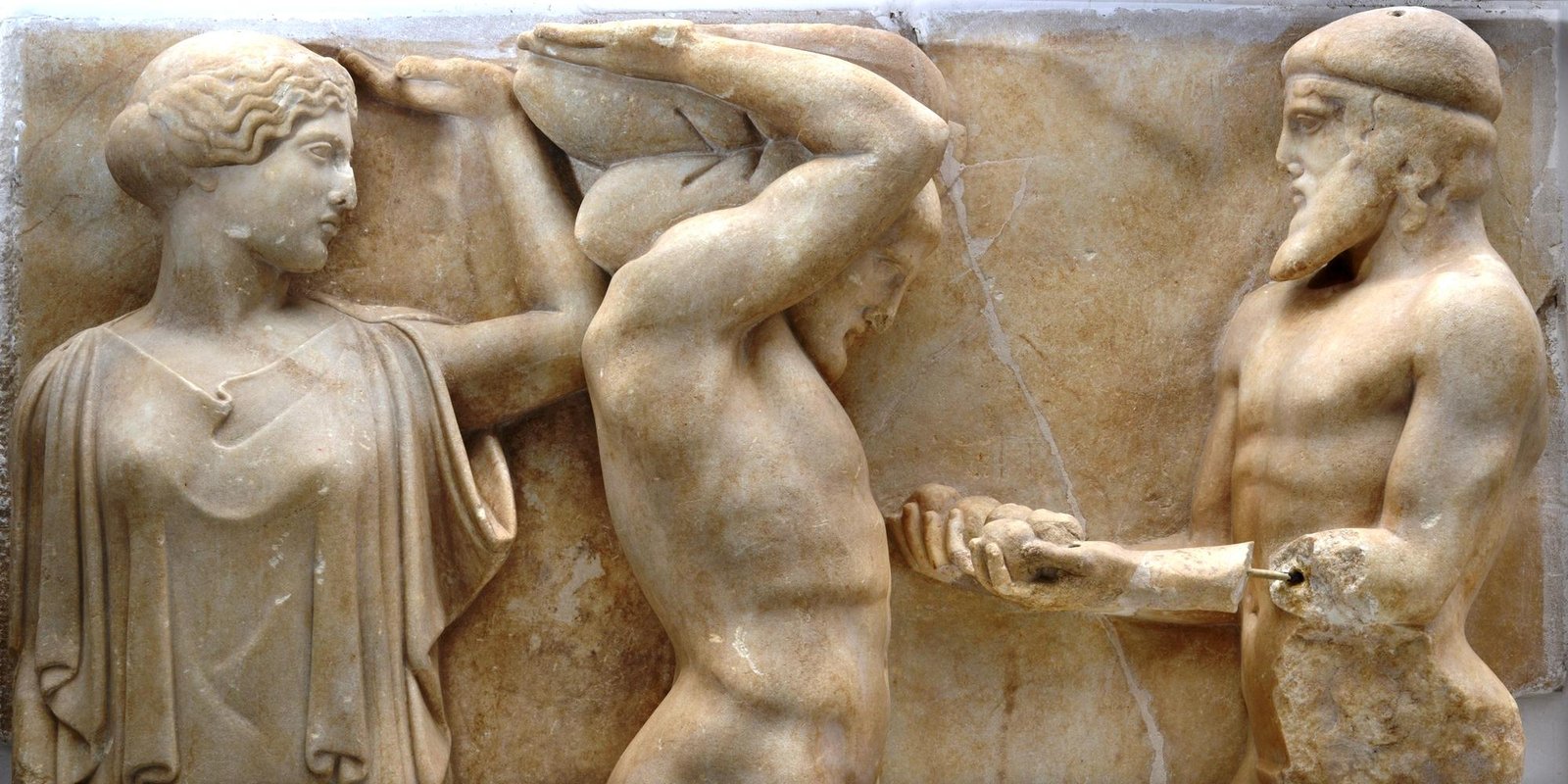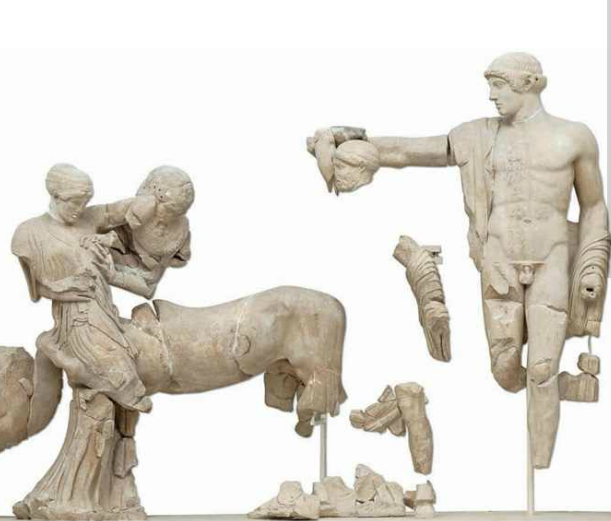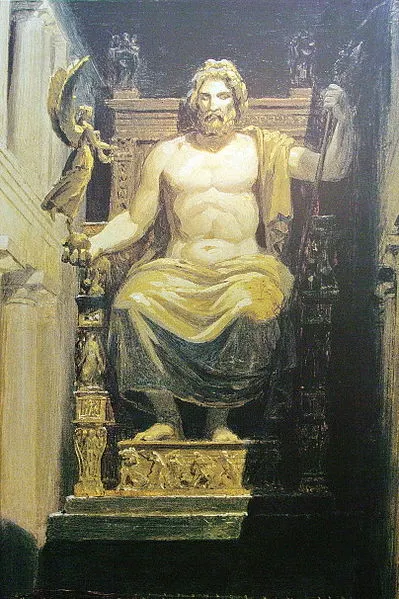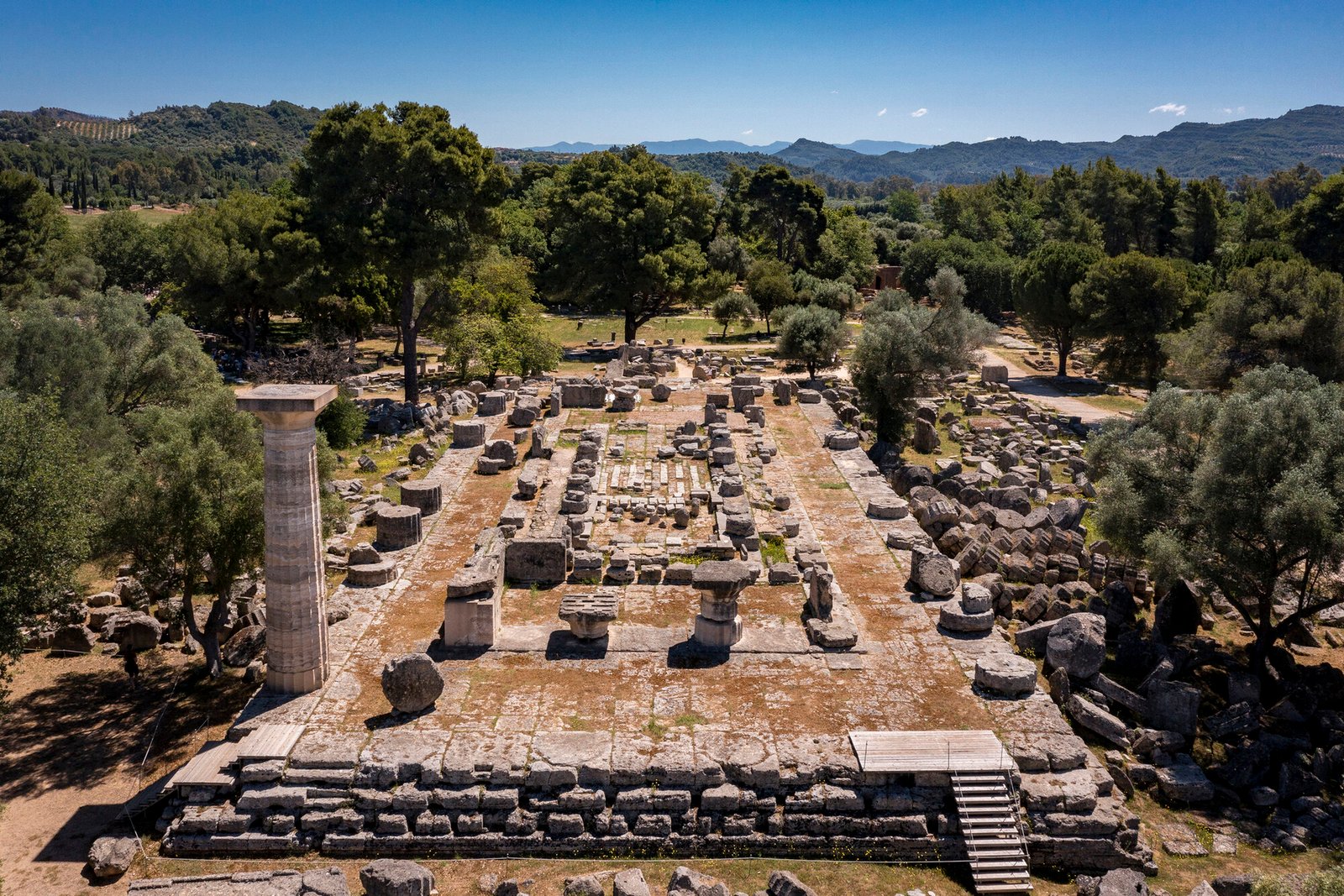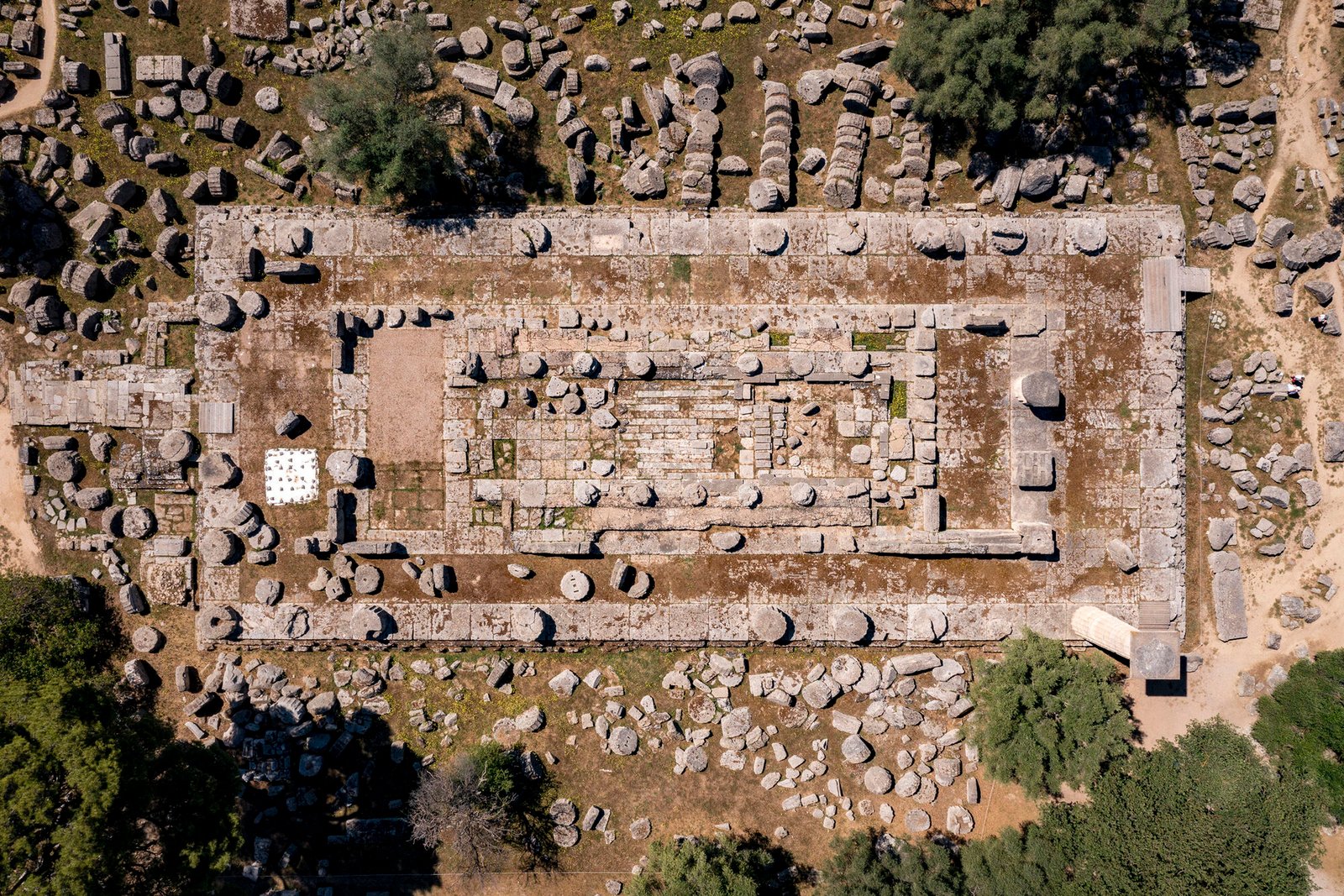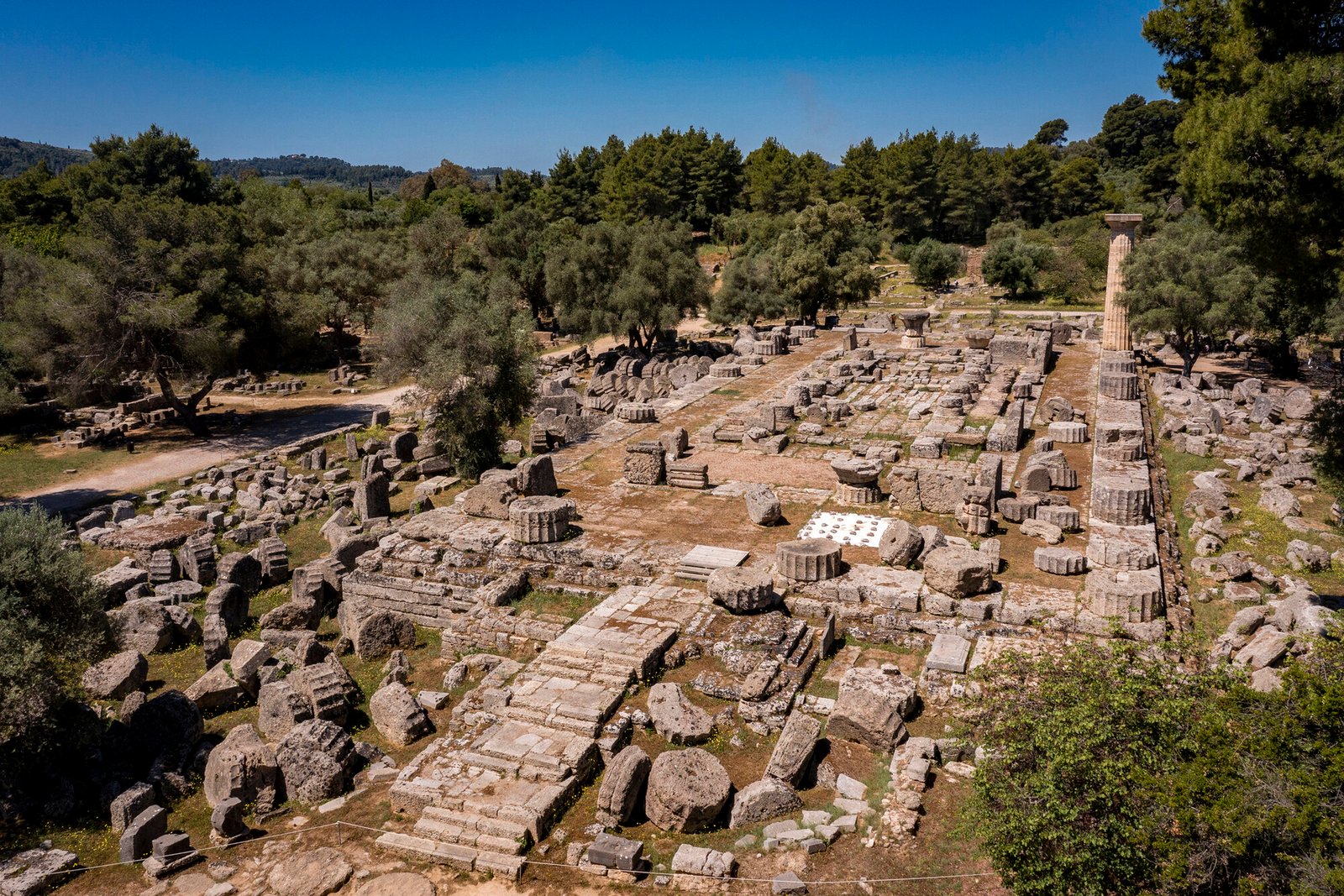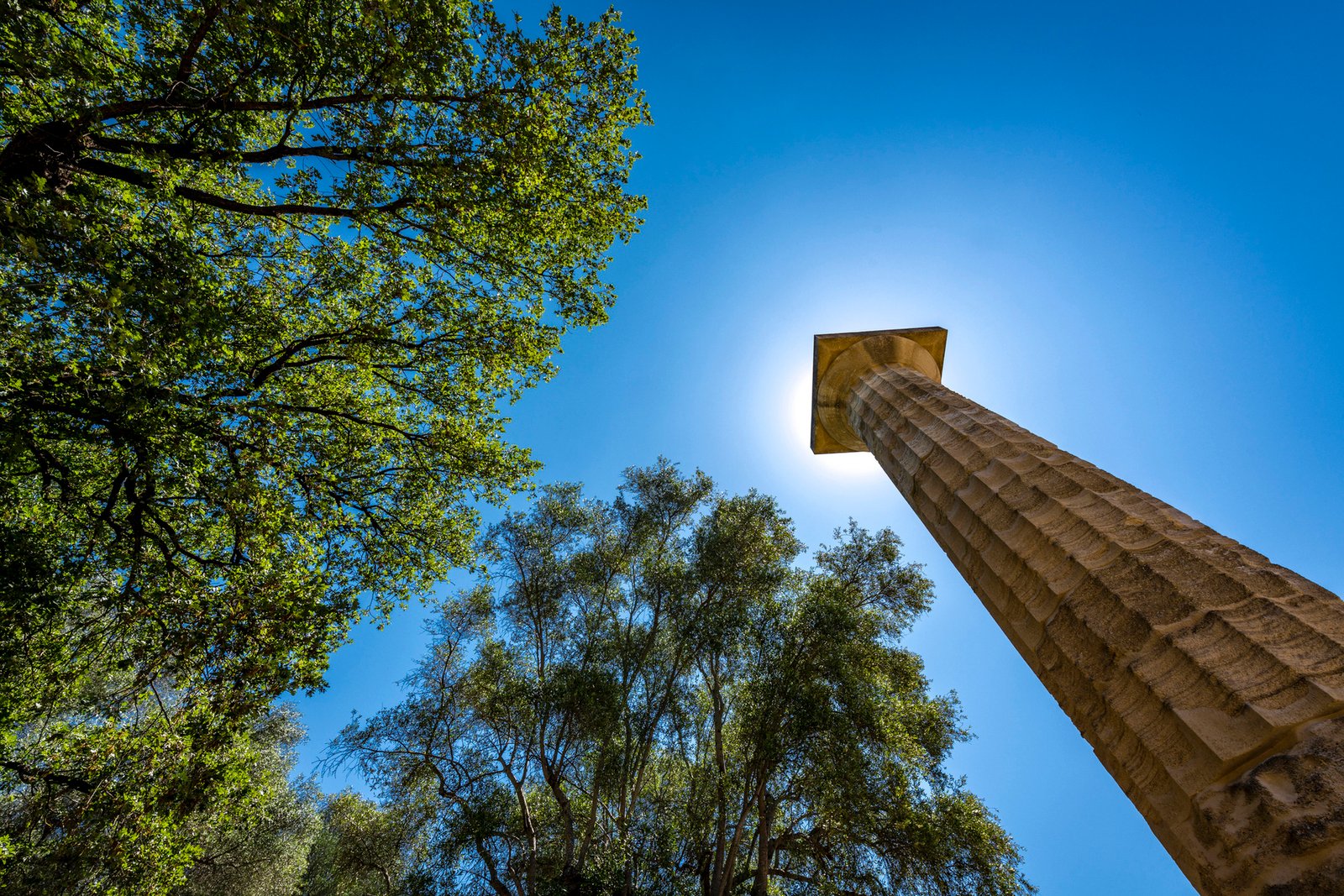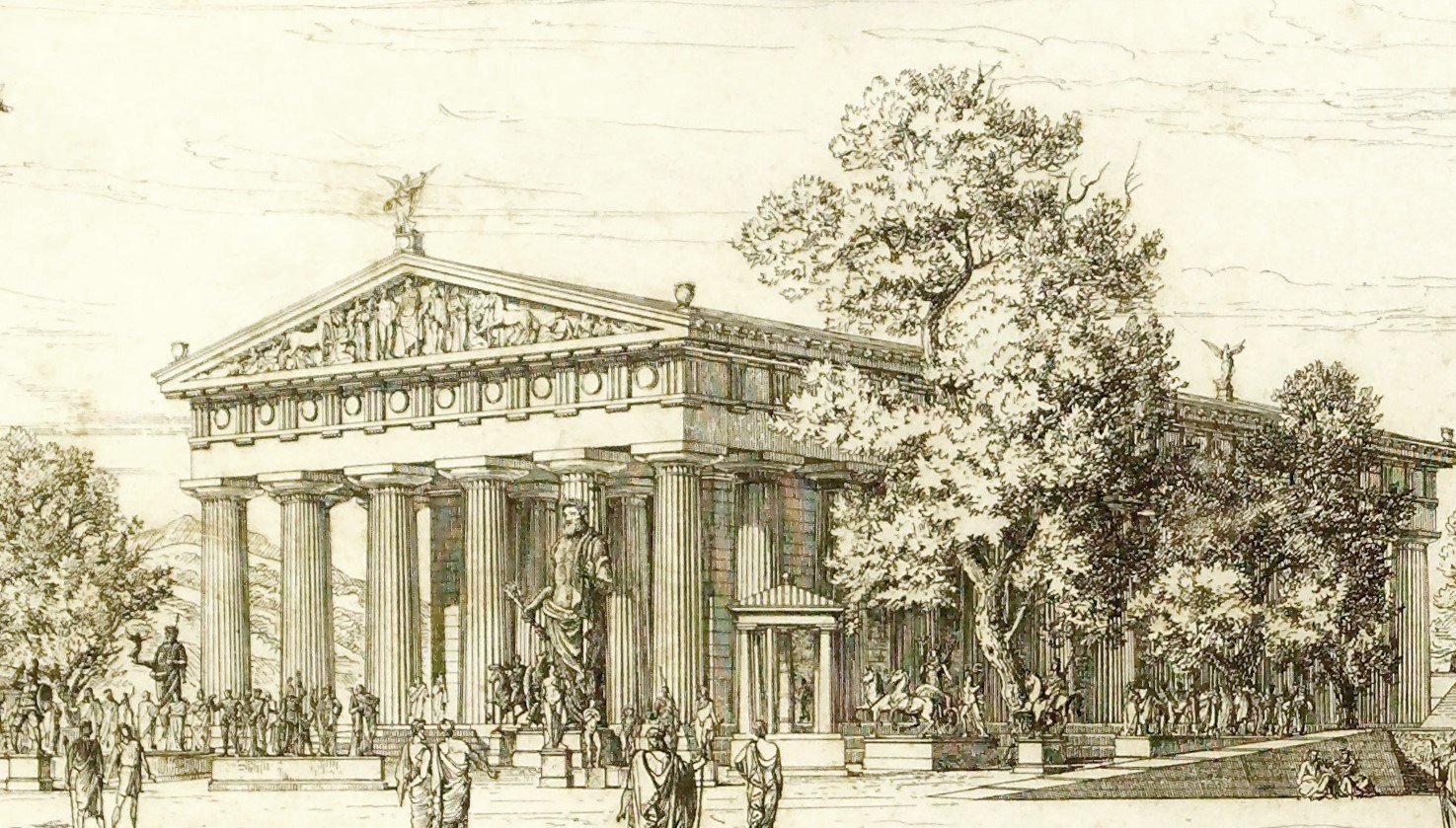
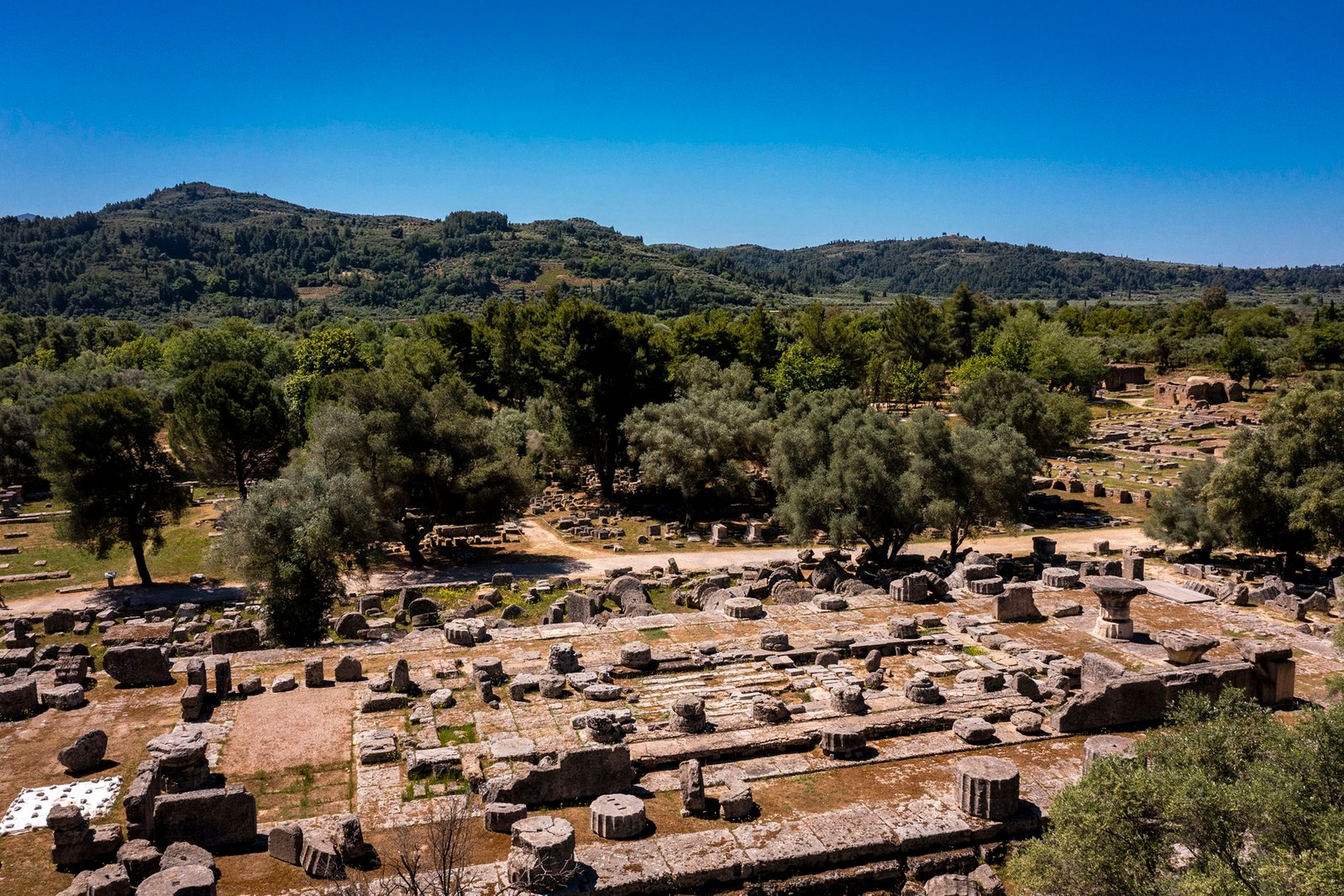
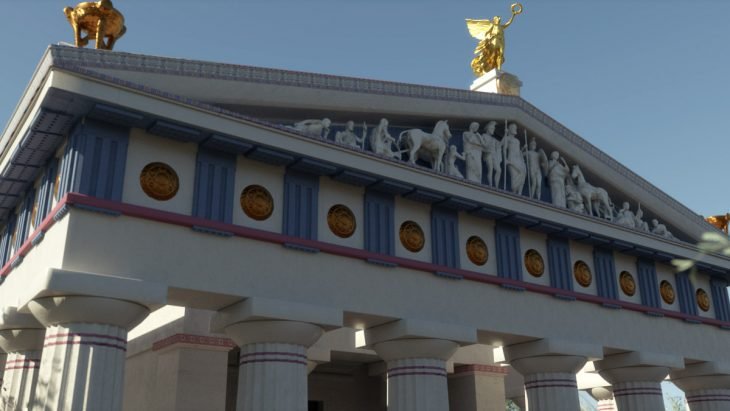
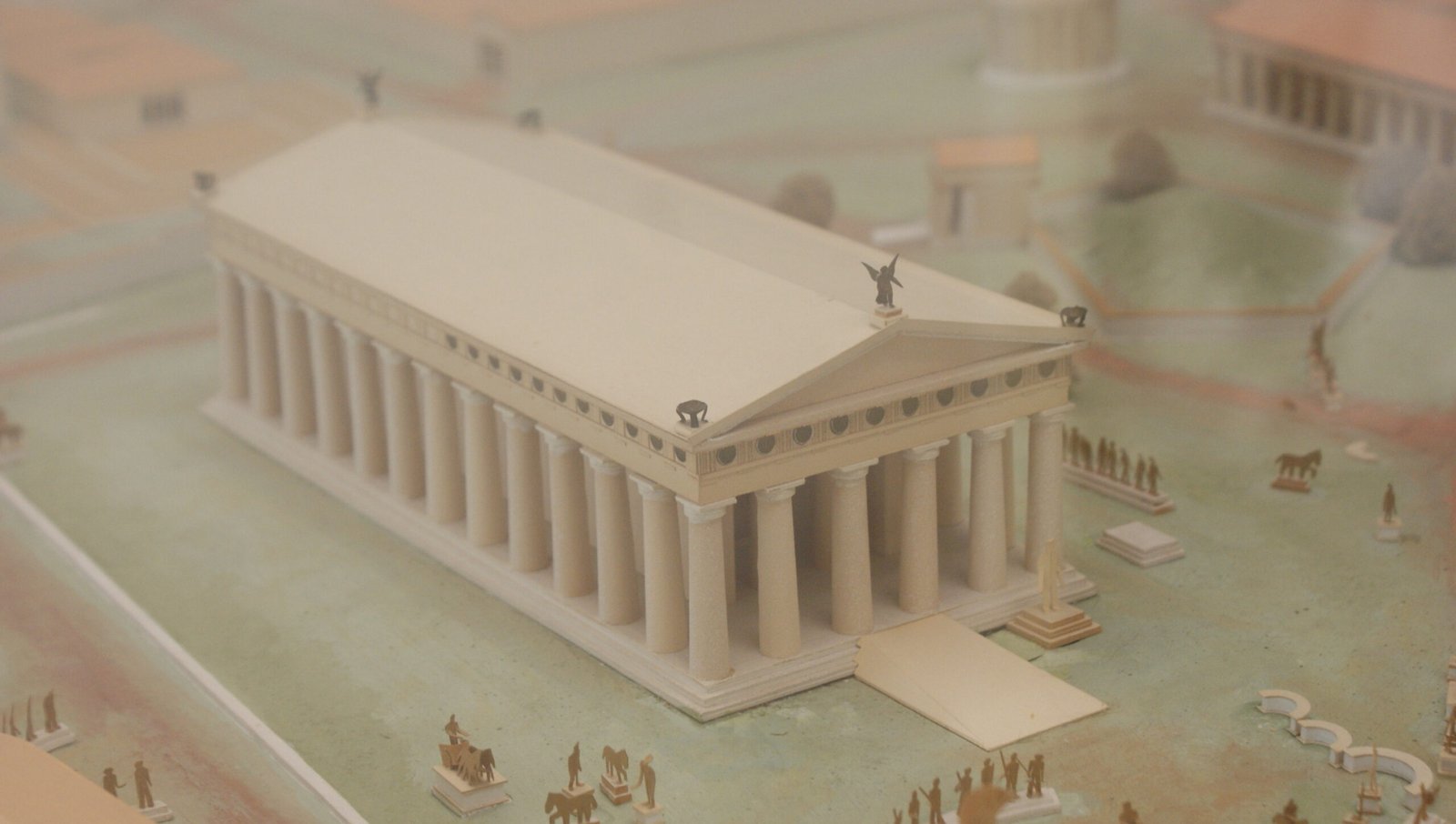
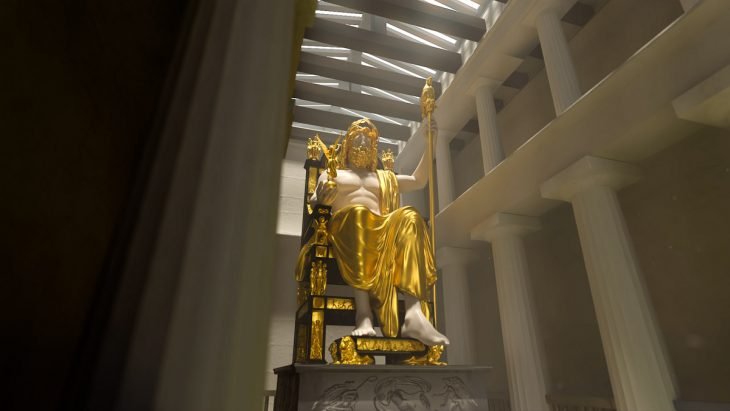
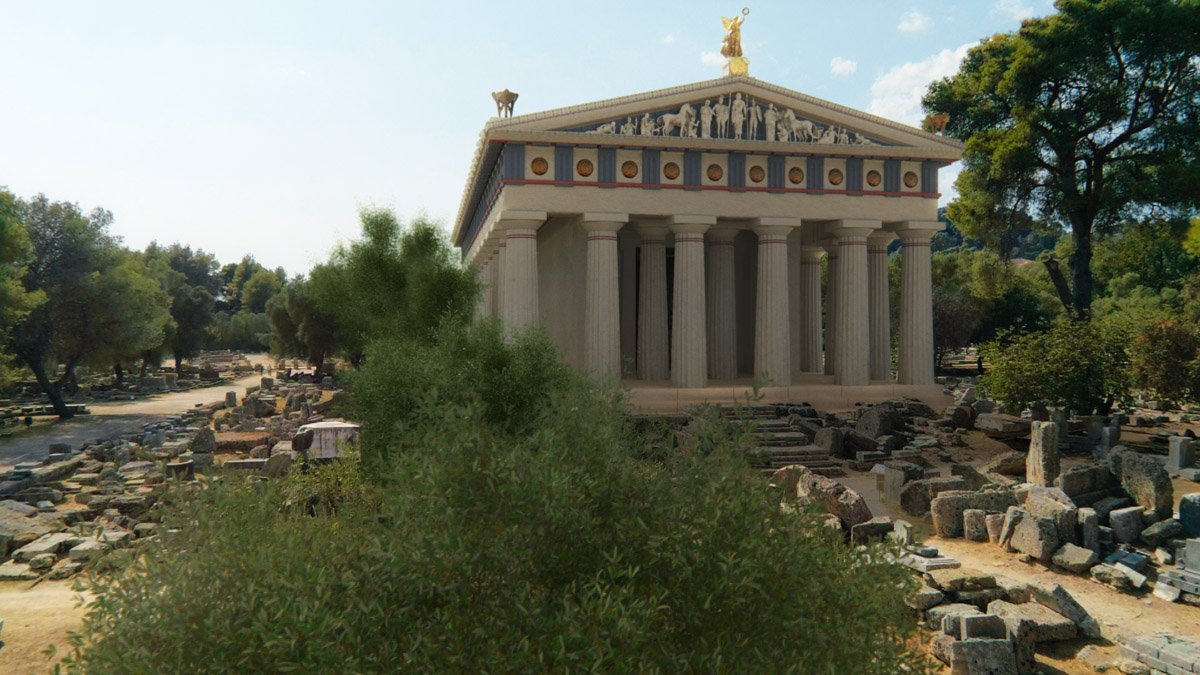

an awe inspiring edifice by the architect Livon of Elis
Built between 470 – 456 BCE by the architect Livon of Elis, it occupied the most prominent position within the sacred precinct (the Altis) of Olympia and was made of a coarse local shell-conglomerate covered in fine white stucco.
With six Doric columns across its front and thirteen along each side, its proportions were both grand and harmonious, signalling the importance of the god to whom it was dedicated.
Inside this awe-inspiring temple, the cella (central hall) was divided into three aisles by two rows of slender columns, and above, the roof was clad in marble tiles.
The temple functioned not only as a sacred cult place, but also as a cultural focal point for the ancient Olympic Games. The great altar of Zeus stood to the side of the temple rather than in front, marking the distinctive layout of the sanctuary.
Visitors would see athletes and spectators converge in the nearby stadium and testify to the fusion of athletic excellence, religious devotion, and communal celebration.
The sculpural decoration
The temple’s sculptural decoration was rich and meaningful: the east pediment depicted the chariot race of Pelops and Oenomaus, while the west pediment illustrated the legendary battle of the Lapiths and Centaurs at Pirithous’ wedding.
Surrounding the porches, a frieze of metopes depicted the Twelve Labours of Heracles, six on each end.
These pedimental sculptures, along with the metopes showing Heracles’s labors, are now displayed in the Olympia Archaeological Museum. These artworks exemplify early Classical sculpture and reflect the high cultural and religious aspirations of the sanctuary. The museum allows visitors to appreciate the high classical style of these 5th-century BC masterpieces, though their original placement high on the temple and their painted colors are lost to time.
The gold and ivory staue of Zeus
Perhaps the most celebrated feature of the temple was the great gold-and-ivory statue of Zeus, created by the master sculptor Phidias.
Nearly twelve metres high, the seated figure of Zeus held in his right hand the goddess of Victory, Nike, and in his left a sceptre, mounted on an elaborate throne. This monumental work was widely regarded in antiquity as one of the wonders of the world. Its presence turned the temple into much more than a building—it became a symbol of divine majesty, human artistry, and the very spirit of Olympia.
The duscrucion of the temple
The Temple of Zeus at Olympia stands as one of ancient Greece’s most significant religious monuments, its destruction marking the end of the pagan era and the beginning of centuries of obscurity.
The Destruction Under Theodosius II
In AD 426, Emperor Theodosius II ordered the burning of the temple as part of Christianity’s systematic elimination of pagan worship. By this time, the sanctuary of Olympia had already entered a period of decline—the Olympic Games had been abolished in AD 393 by Theodosius I, ending over a thousand years of athletic and religious tradition.
The Final Collapse
The fire-damaged structure couldn’t withstand the powerful earthquakes of AD 551 and 552 that devastated the eastern Mediterranean. The temple’s massive Doric columns, standing about 10.5 meters high, toppled and collapsed into ruins. The site was subsequently buried under layers of silt from the nearby Alpheios and Kladeos rivers, which gradually flooded the sanctuary area, hiding it for over a millennium.
The rediscovery and restoration of the temple
The rediscovery of Olympia emerged from the Enlightenment’s intense fascination with classical antiquity. Eighteenth-century European intellectuals viewed ancient Greece as the pinnacle of human achievement, spurring scholarly expeditions to document lost monuments.
In this climate, Richard Chandler, an English scholar sponsored by London’s Society of Dilettanti, traveled to Greece between 1764 and 1766. Visiting the buried site of Olympia in 1766, Chandler became the first modern scholar to correctly identify the temple’s remains, relying on careful study of ancient texts, particularly Pausanias’s 2nd-century AD travel guide. His findings, published in Travels in Greece (1776), put Olympia back on the map after more than a millennium of obscurity.
Actual excavation began with the French expedition of 1829, part of the Morea Scientific Mission during Greece’s early independence. The French team removed several metopes depicting the Twelve Labors of Heracles, which were transported to Paris and remain in the Louvre today.
The most comprehensive work was conducted by the German Archaeological Institute beginning in 1875. These systematic excavations uncovered the temple’s ground plan, architectural elements, and much of its sculptural program, employing unprecedented rigor in documentation for the era.
Today, the ruins of the Temple of Zeus invite us to imagine the awe it inspired in ancient visitors, and to remember the enduring legacy of Olympia as the birthplace of the Olympic ideal.
Visiting the Temple of Zeus remains a moving experience. As you walk among the fallen columns and the scattered blocks, you connect with a world in which humanity reached for the divine through sculpture, architecture, and ritual.
The remains prompt reflection on how the ancient Greeks conceived of greatness—in the gods, in athletics, in art—and challenge modern viewers to carry forward that sense of aspiration and wonder.

